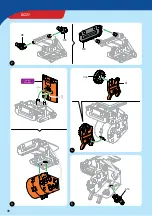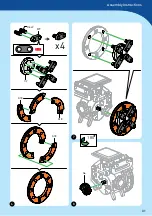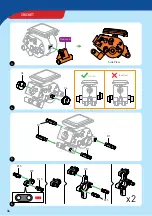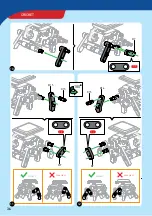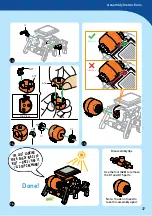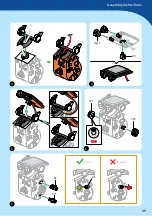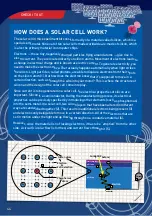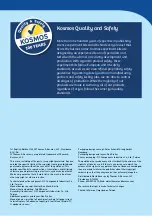
CHECK IT OUT
44
44
Sunlight (Photons)
Electron
p-Silicon
Conductor
Protective layer
n-Silicon
Current
1
4
5
2
Si
Si
Si
Si
P
Si
Si
Si
Si
Electron
Extra electron
Silicon atom
Phosphorous
atom
3
HOW DOES A SOLAR CELL WORK?
The solar cell in this experiment kit consists mostly of a material called silicon, which is a
special semi-metal. Nine out of ten solar cells made worldwide are made of silicon, which
is also the primary material in computer chips.
Electrons — those tiny, negatively charged particles flying around atoms — give rise to
electric current. They are located directly on silicon atoms. Movement of electrons leads to
a change in electrical charge and is known as electric current. To generate electricity, you
need to make the electrons move. That actually happens automatically when light strikes
the silicon. Light particles, called photons, are able to displace electrons from their spots
on the silicon atom (1). But how does the electron know that it’s supposed to move in a
certain direction, such as through the wire into your motor? This is where the structure of
silicon and the design of the solar cell come into play.
Since current is to be generated in a solar cell, the electrical properties of silicon are
important. Silicon is a semiconductor. During the manufacturing process, its electrical
properties can be precisely specified by introducing other elements (such as phosphorous)
into the semi-metal. In a solar cell, two silicon layers that have been altered in different
ways are sandwiched together (2). This results in additional electrons being present (3)
and electrons only being able to move in a certain direction. All of the electrons that are
set in motion under the light end up flowing through on a conductive material (4).
However, since the material is not lacking electrons, it has to be “emptied” from the other
side. A circuit (circular flow) is formed, and current flows through it (5).
Summary of Contents for SolarBots
Page 16: ...ARMIE 14 B29 B30 180 D4 C11 C6 D3 B1 2 3 ...
Page 20: ...BRONTO 18 C21 C21 x2 C19 D15 Correct Incorrect x2 D15 D15 C24 1 1 1 1 1 1 3 4 5 7 6 ...
Page 21: ...19 Assembly Instructions x2 D15 D15 B24 B18 B21 180 1 1 2 2 2 2 8 9 ...
Page 24: ...AXEL 22 C12 B7 D6 D3 D8 C7 D8 C9 C23 B8 Solar Gearbox 1 1 3 4 5 ...
Page 25: ...23 Assembly Instructions C16 A1 x2 A18 A18 A18 x8 x2 B9 C2 D6 D13 180 1 1 6 7 9 8 ...
Page 32: ...DIZZY 30 D8 D8 B8 Solar Gearbox C16 A1 D13 2 3 5 4 ...
Page 33: ...31 Assembly Instructions x4 B9 C2 A18 D6x2 A18 A18 A6 1 1 180 6 7 8 ...
Page 41: ...39 Assembly Instructions B6x2 D11 1 2 D2 D2 D15 Correct Incorrect C25 C25 1 1 1 1 3 4 6 5 7 ...
Page 42: ...MAJOR 40 D2 Correct Incorrect D15 C26 x4 D15 Correct Incorrect Correct Incorrect 8 10 11 9 ...

